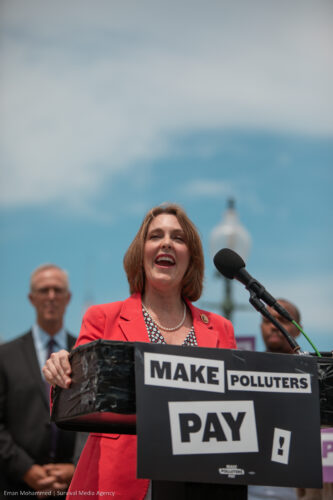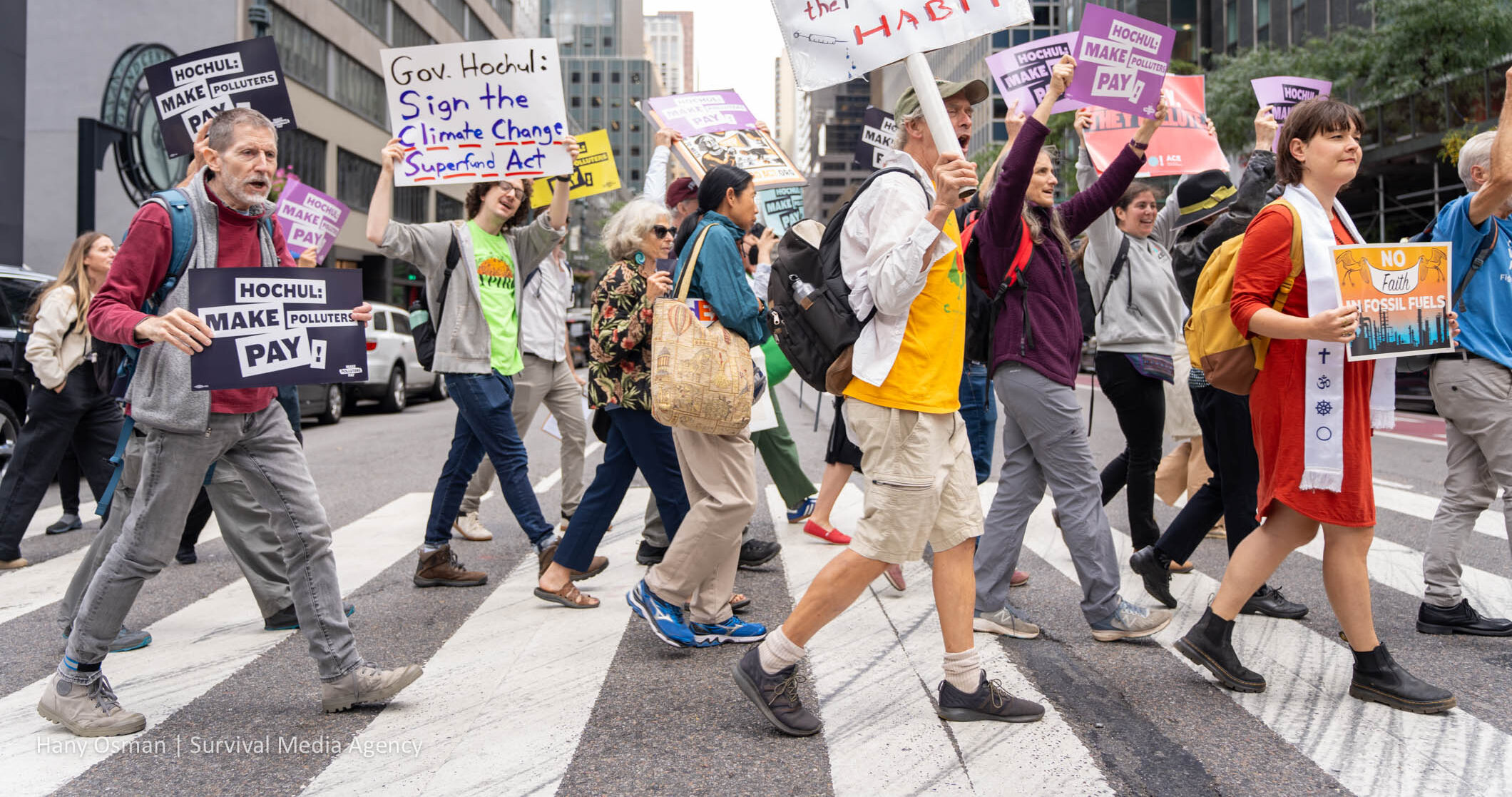This toolkit is designed to help advocates, organizations, and legislators address one of the most common concerns about Climate Superfund legislation: the potential impact on consumer prices.
The fossil fuel industry frequently claims that making them pay for climate damages will lead to higher prices at the pump and increased energy costs for consumers.
However, both economic analysis and real-world evidence demonstrate that these concerns are unfounded.
In fact, Climate Superfund legislation will reduce the costs to communities and taxpayers caused by the escalating climate crisis, including housing, health, and insurance costs, while investing in local services, including community resilience, disaster preparation and recovery.
Below you’ll find detailed explanations, talking points, and resources to help communicate why Climate Superfund bills are designed to make polluters pay — not the public.
Why Superfund Won’t Raise Prices
Global markets set oil and gas prices, not individual companies. Global prices do not reflect fixed fees based on the past behavior of the big oil companies. In addition, because there are many providers of California gasoline, no single company can raise prices without losing customers to competitors.
Consumers are already paying 100% of climate damage costs through taxes, insurance premiums, and disaster recovery. The Climate Superfund shifts these existing costs from taxpayers to the big oil companies responsible for past emissions that helped supercharge the climate crisis and extreme weather events. It doesn’t increase the costs of producing and selling gasoline.
Understanding the Economics
Global Market Forces
As the American Petroleum Institute itself acknowledges, “Petroleum prices are determined by market forces of supply and demand, not individual companies.” Oil and gas prices are determined by worldwide supply and demand dynamics. No individual company — or even group of companies — can unilaterally control these global prices. Even OPEC, while they can influence global supply levels, cannot dictate prices in specific regions or for specific companies.
Competition Drives Pricing
If Company A tries to raise prices above market rates to cover their Superfund payments:
- Customers will simply buy from Company B offering market prices
- Company A loses market share and profits
- This forces Company A to return to market prices regardless of their Climate Superfund obligations
Local Price Constraints
The price at your local gas pump is built from:
- Global oil prices (roughly 60% of pump price)
- Refining costs (about 15%)
- Distribution and marketing (about 15%)
- Taxes (about 10% *but differs state to state).
Superfund assessments don’t affect these components — they’re too small to impact global prices and too far upstream to affect local costs.
The Real Cost Dynamic
The fossil fuel industry’s claims about needing to pass costs to consumers become particularly hollow when examining their financial statements.
In the second quarter of 2024, major oil companies made staggering profits:
- ExxonMobil: $70,513 per minute
- Shell: $48,024 per minute
- Chevron: $35,691 per minute
In 2023, oil company CEOs received substantial compensation packages:
- ExxonMobil’s CEO, Darren Woods, received $36,919,898
- Chevron’s CEO, Mike Wirth, received $26,489,856
- Shell’s CEO, Wael Sawan, received £7,940,000 (approximately $10 million)
To put this into perspective:
- Annual Climate Superfund payments would represent less than 1% of these companies’ profits
- Companies spend more on stock buybacks than their projected Climate Superfund obligations
- Executive compensation alone could cover significant portions of assessment payments
The annual payments required by Climate Superfund bills represent a small fraction of these massive profits. When companies are spending billions on stock buybacks and shareholder dividends, they clearly have the financial capacity to pay for some the massive damage they’ve caused without raising consumer prices.
Historical Precedent
The original Superfund law (CERCLA) provides a clear historical example. When Congress passed CERCLA in 1980, industry groups claimed that making companies pay to clean up toxic waste sites would devastate the economy and drive up consumer prices. These predictions proved entirely false – companies have paid billions for cleanup without raising consumer prices because market competition prevents them from doing so. The same economic principles apply to climate damage payments.
Messaging
-
1
The costs of climate change are already being paid – except right now they're being paid solely by taxpayers and communities instead of the companies responsible.
-
2
These companies made trillions in profits while knowingly causing climate damage. They can afford to pay their fair share without raising prices.
-
3
Just like we make companies clean up toxic waste sites, big oil must clean up their climate disasters.

FAQs

Actually, they can’t without losing customers to competitors. These payments are a fixed assessment based on past pollution. They do not affect ongoing production costs. Even if one company tried to raise prices, they would lose business to other companies. That’s why economists across the political spectrum agree these costs can’t be passed on to consumers.
Even if every state adopted similar legislation, the total payments would still represent a small fraction of industry profits for a small number of companies. If companies claim they can’t afford to pay for the damage they’ve caused without raising prices, that’s a clear sign we need to accelerate the transition to cleaner energy sources.
Far from it. These companies are recording the highest profits in their history. When ExxonMobil can spend $20 billion on stock buybacks, they can afford to pay for the damage they’ve caused without disrupting their operations.
Climate Superfund legislation helps families in several ways:
- Local tax increases are not required to pay for climate damage
- It protects home values by funding community resilience
- It reduces the devastating financial impact of climate disasters on families and local governments
Every dollar spent on climate resilience saves communities in future disaster costs. By making polluters pay their fair share now, we’re investing in:
- Protected property values
- Stable insurance markets
- Resilient infrastructure
- Preserved local services
- Reduced disaster recovery costs
The funds will support projects and programs specifically designed to mitigate and respond to climate damages. All funded programs must include strategies to increase employment opportunities while addressing climate impacts. The program ensures coordinated action through regular consultation with key state agencies to implement the most effective solutions.
